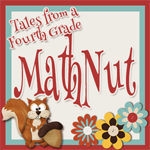Last week, my students started learning to convert units of
capacity. I began by telling them a story I adapt from Voltz Math.
Far, far, away in land called Capacity
Kingdom lived a King. This king was huge! In fact, he was a giant, so
everyone called him King G. {I drew a Big "G" on my white board.} Then I asked my kiddos if they knew what a king’s wife was
called. They did J. Next, I told them King G was playah. I
nodded my head and paused for dramatic effect. Then, I told them he had four
queens. {I drew four "Q"s inside the Big "G" on the board.}
Next I asked my kiddos if they knew
what the kids of kings and queens are called. They did J. I told my students that each queen had one prince and one princess. {I drew two "P"s inside each "Q" saying this queen had one prince and one princess as I drew each "P"} This is
when I began to hear my kids whispering that the King had 8 kids.
Then I asked my students if they
knew what princes and princesses wear on their heads. They did J. I told them each
Prince and Princess had two crowns. They had one they wore on special occasions
such as a ball. They wore the other crown everyday to places like the mall.
{ I drew two "c"s inside each "P" chanting ball and mall as I drew each "c"} Next I
told them each crown had 8 opals on it.
Finally, I told my kiddos that I told them that silly story
to help remember how to draw the big "G" when you are converting capacity.
Let me tell you, it did!! I spent 10 minutes telling that story on Monday. On
Friday, I gave a quick assessment to see how many of my 104 students could draw
the big “G”. I was AMAZED almost every student remembered it exactly!!
After telling the story I gave each a big “G” foldable to
put in their math notebooks. We practice using the using the big “G” to convert
customary units of capacity.
Click Here to Grab your Free Foldable {TPT}
Click Here to Grab your Free Foldable {TN}
King
Gallon
Queen
Quart
Prince/Princess
Pint
Crown Cup
Opal Ounces


















